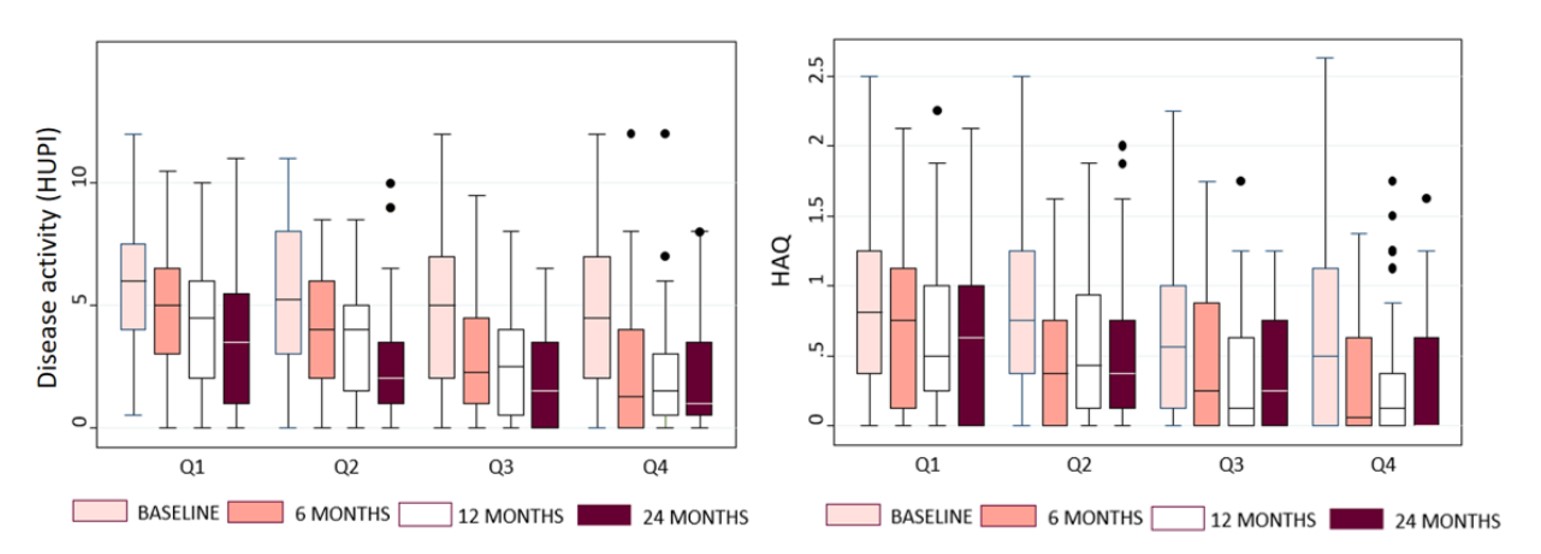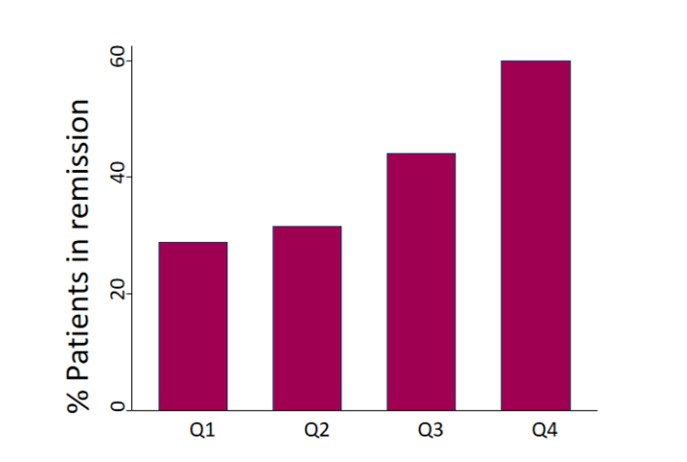Session Information
Date: Monday, November 18, 2024
Title: RA – Treatment Poster III
Session Type: Poster Session C
Session Time: 10:30AM-12:30PM
Background/Purpose: The window of opportunity is well established in patients with rheumatoid arthritis (RA) but it is unclear in patients with undifferentiated arthritis (UA). This study described changes in the management of patients with UA over 20 years in a registry of patients with recent-onset arthritis in a tertiary hospital in Madrid and analysed whether the concept of a window of opportunity could exist in these patients.
The objective was to describe the influence of disease-modifying antirheumatic drugs (DMARD) on activity and disability in patients with UA.
Methods: All patients classified as UA at the first visit from September 2001 to December 2019 were included. Demographic, clinical, analytical and treatment data were collected in a protocolised manner at four consecutive visits (baseline, 6 months, 1 and 2 years). To assess management changes, patients were grouped into four five-year periods (Q1 from 2001 to 2004, Q2 from 2005 to 2009, Q3 from 2010 to 2014 and Q4 from 2015 to 2019). Statistical analysis was performed with Stata 14.1 using the appropriate tests for bivariate analysis according to the type and distribution of variables. A multivariable model nested by patient and visit (xtgee command) was fitted to analyse the influence of the different variables on disease activity. All variables differing between five-year periods and those related to arthritis activity were included.
Results: 309 patients were included in the analysis (77.7% female; age at disease onset 52 years [RIQ: 39-63]). The percentage of non-smokers decreased from the first to the last five-year period (67 vs 42.3%; p< 0.0001). There was a trend towards an increase in seropositive cases (RF and anti-CCP) from the first to the last five-year period (p=0.013 and p=0.001, respectively). Time to first consultation and initiation of first DMARD decreased respectively from 6.6 (RIQ: 4.1- 10.0) and 14.1 (RIC 5.2-31.5) months in the first five-year period to 3.5 (RIQ: 1.8-7.6) and 6.4 (RIC 2.8- 18.4) months in the last five-year period (p=0.0019 and p=0.0001). Over the five-year periods, the use of methotrexate increased (16.7% more, p=0.004) and the use of antimalarials and sulfasalazine decreased (28.9% and 13.7% less, respectively, p=0.014). Disease activity progressively decreased, with a higher percentage of patients in remission at two years (25% more in the last five years p=0.046) and a progressive improvement in functionality, with a higher percentage of patients with mild disability in the last five-year period (26.3% more p=0.028) (Figures 1 and 2). After two years of follow-up, 45.4% of patients maintained the diagnosis of UA, 23.6% changed the diagnosis to RA, 4.6% to spondyloarthropathies and 26.4% to other processes, with no significant changes over time. Adjusting for all variables differing between the five-year periods (seropositivity, smoking and treatments), as well as those affecting disease activity (sex and age), a decrease in arthritis activity was observed in all five-year periods compared to the first (Q2 and Q4 p=0.032, Q3 p=0.003).
Conclusion: Our preliminary results suggest that the therapeutic window of opportunity also exists in patients with UA by showing improvement in disease activity and functional capacity.
To cite this abstract in AMA style:
Quiroga Colina P, Álvarez M, Nikitsina M, Dueñas M, Sáez J, Valero C, García-Vadillo J, Ahijón Lana M, Castañeda S, Tomero Muriel E, Vicente-rabaneda E, Romero A, Llorente I, Uriarte-Ecenarro M, García-Vicuña R, Ortiz A, González-Álvaro I. The Window of Opportunity: A Concept Also Applicable to Undifferentiated Arthritis [abstract]. Arthritis Rheumatol. 2024; 76 (suppl 9). https://acrabstracts.org/abstract/the-window-of-opportunity-a-concept-also-applicable-to-undifferentiated-arthritis/. Accessed .« Back to ACR Convergence 2024
ACR Meeting Abstracts - https://acrabstracts.org/abstract/the-window-of-opportunity-a-concept-also-applicable-to-undifferentiated-arthritis/


